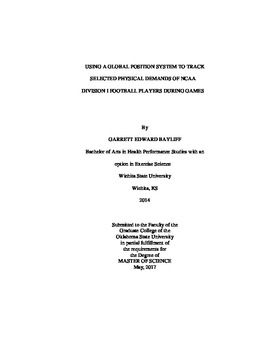| dc.description.abstract | PURPOSE: To compare differences in distance traveled, maximum velocity, accelerations,decelerations, and high intensity change of directions in Division I football players. METHODS:Twenty-one Division I football players, ages 18-24, wore global positioning system (GPSs)monitors during games to track selected variables of each athlete. Athletes were grouped bysimilarities in playing position in the following manner; wide receiver (WR) and defensive back(DB), and offensive linemen (OL) and defensive linemen (DL). Parameters measured were totaldistance covered, maximum velocity, total inertial movement analysis (IMA) (movements >3.5m/s2), distances traveled in deceleration and acceleration using two velocity categories for each(Deceleraton band 1=3-10m/s2 Deceleration band 2=2-3m/s2, Acceleration band 7=2-3m/s2, andAcceleration band 8=3-10m/s2). Inclusion criteria included that athletes must have participated in70% of the total plays during the games selected. A Oneway ANOVA analysis with 95%confidence interval for means was used to determine differences (p<.05) among groups. NewmanKeuls post hoc tests were used to determine mean differences. RESULTS: The results of Thepresent study indicated that DBs scored significantly (p<0.05) higher in total distance covered,total IMA, deceleration and acceleration in both Band 1 and Band 2 than WRs. There was nosignificant difference between DBs and WRs in maximum velocity. DL scored significantly higherin maximum velocity, deceleration and acceleration Band 1 than OL. There were no significantdifferences between DL and OL in total distance covered, total IMA, and deceleration andacceleration Band 2. CONCLUSION: DBs and DL travel further, average higher maximumvelocities, and accrue more high intensity, explosive movements throughout a game than WRs andOL.This study provides quantification of positional physical demands and comparisons ofcollegiate football games and could be used to develop position specific training programs to betterprepare athletes for play. | |
